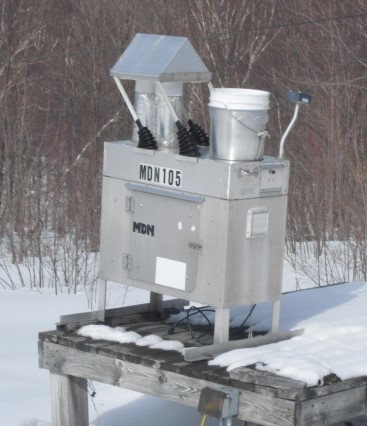Details and Metadata
Printer-friendly version View XML version Download Ecological Metadata Language file
Methods
The methods followed in the creation of the dataset, including description of field, laboratory and processing steps, and quality control procedures
Current Methods
Weekly Sampling
Started: 2012-10-29During the fall of 2012 the sampling frequency changed from event based to the weekly composite sampling that is typical of the network. Precipitation collected over course of one week. Sampling period is Tuesday to Tuesday.
Instrumentation: N-CON and ACM
Deposition collection
Started: 2004-07-27A special collector was designed for MDN which is a modification of the wet-only deposition collector used by NADP for other observations. The modifications include replacing the collection bucket with a smaller insulated sampling chimney.
Sampler processes
Started: 2004-07-27The lower portion of the sampler is enclosed and insulated. A small space heater is used to maintain the winter temperature between 10 and 15 °C to prevent samples from freezing. Heat from the interior rises up the chimney to warm the collection funnel which melts ice and snow on contact with the funnel. A ventilation fan pulls filtered air through the sampler during warm weather to moderate the inside temperatures.
Mercury sampling train
Started: 2004-07-27The mercury sampling train consists of an approximately 128-mm diameter, borosilicate glass funnel, an acid-cleaned, wide-bore (3-mm) capillary tube, and a 2-liter, borosilicate glass bottle. The capillary tube is connected to the funnel by a ground glass fitting. The opposite end of the capillary tube is expanded to form a sphere with a diameter slightly larger than the mouth of the sample bottle. A small hole in the sphere allows water to drain into the sample bottle.
Sample bottle prep
Started: 2004-07-27Sample bottles are pre-charged with 20.0 mL of dilute (0.12 M) hydrochloric acid as a preservative to prevent microbial action and provides sufficient chloride ion to complex mercury in solution and prevent conversion to and loss of Hg0
Sample collection
Started: 2004-07-27The field operators receive a pre-cleaned sampling train each week. Every Tuesday, the exposed sampling train is removed using clean techniques and returned to the MDN laboratory, Frontier Global sciences, Inc. in Seattle, WA (Hg Analytical Laboratory, "HAL"), along with the sample bottle containing any collected precipitation.
Handling and overflow
Started: 2004-07-27All operators wear plastic gloves when handling the sampling train and follow special procedures to avoid contaminating the sample. Any overflow from the bottle is collected and measured to determine the total precipitation amount, but it is not included with the sample sent to the lab.
Precipitation monitoring
Started: 2004-07-27Each site is also equipped with a weighing-bucket rain gauge that provides a continuous record of rainfall amounts. Rainfall is recorded to the nearest 0.01 in. The rain gauge also monitors the precipitation sampler, recording whether the sampler was properly open during wet periods and closed during dry periods.
Past Methods (No longer in use)
- Overview of event based Hg sampling
Started: 2004-07-27
Ended: 2012-10-29From summer 2004 to spring of 2013 sampling was done on an event basis with co-located wet-only precipitation collectors; An Aerochemetrics (ACM) and a N-CON Systems (N-CON). Precipitation was collected in the morning after every precipitation event with both ACM and N-CON collectors. Lids open in response to precipitation.
Instrumentation: NCON and ACM
Dataset Fields
Detailed documentation of the fields comprising the dataset, including the type of measurement, units where applicable, and any controlled vocabularies or code lists present in the data
Field Name Caption Description Additional Information SITEID Site ID Site identification code
Nominal DATEOFF Date Off Date and time that sample collection ended
DateTime Date/Time Format: M/D/YYYY hh:mm DATEON Date On Date and time that sample collection began
DateTime Date/Time Format: M/D/YYYY hh:mm RGPPT Precipitation Precipitation amount as measured by rain gauge
Ratio Units: milliliters
Precision: 0.01SVOL Sample Volume Volume of the sample analyzed
Ratio Units: milliliters
Precision: 0.1SUBPPT Calculated Precipitation Precipitation amount, equal to gauge precipitation or, when absent, calculated from bottle catch volume
Ratio Units: milliliters
Precision: 0.01HGCONC Mercury Concentration Concentration of mercury measured in the sample
Ratio Units:
Precision: 0.01HGDEP Mercury Deposition Deposition of mercury derived from the precipitation and concentration data
Ratio Units: nanograms per square meter
Precision: 0.01SAMPLETYPE Sample Type Type of sample collected (wet, dry, invalid or unknown)
Nominal QR Quality Code Qualtiy assurance code, A=fully qualified, no problems; B=valid data with minor problems; C= invalid data, -=unknown
Nominal NOTES Lab Notes Notes attached by lab
NominalMDN Sample Problem Codes
+ showAppears in data as Meaning of code e extended sample time (> 8 days) YRMONTH Sample Year-Month Month and year of sample
Interval Units: DATEMOD Date Mod Unknown
DateTime Date/Time Format: M/D/YYYY hh:mm Sampling Equipment
Equipment and software used to collect data, including how that equipment was used.
Past Sampling Equipment (No longer in use)
Precipitation collector
Started: 2004-07-27
Ended: 2016-01-19Aerochemetrics (ACM) automated precipitation collector.
Frequency: Weekly
Automated precipitation collector
Started: 2005-08-01
Ended: 2012-10-29N-CON Systems (N-CON) automated precipitation collector.
Frequency: Event based
Precipitation collector
Started: 2012-10-29
Ended: 2015-03-03N-CON Systems (N-CON) automated precipitation collector.
Frequency: Weekly
Site Characteristics
The spatial extent of the dataset site coverage, and descriptions of the spatial extent and context for the data collection
- Site Description
West slope of Mount Mansfield in an open field at the Proctor Maple Research Center. Site has a west aspect and an 8% slope
Minimum Altitude: 399 meter
Maximum Altitude: 399 meter


 Details
Details